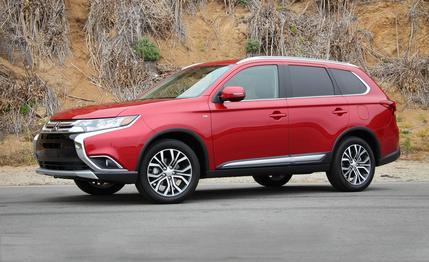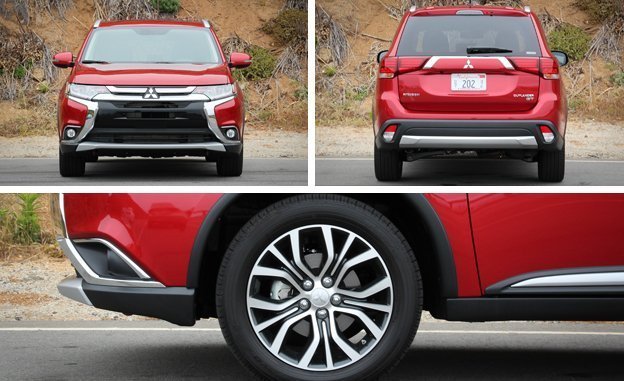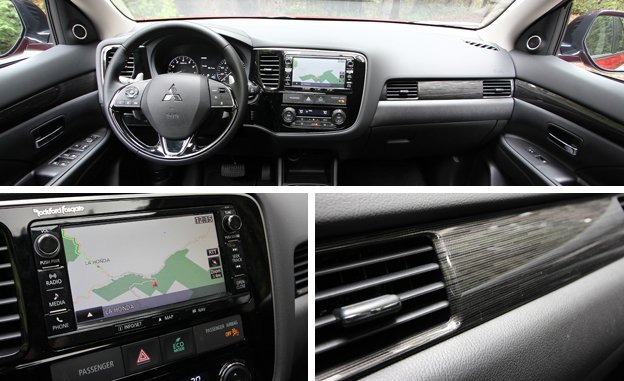
 First Drive Review
First Drive Review
Mitsubishi, the one-time purveyor of such awesomeness as the Starion ESI, the 3000GT VR-4, and the freshly discontinued Evo, is a shell of its former self. Forced by a competitive market and a lack of production partners to pare down its product line to a pair of crossovers, the Mirage econobox, the dated Lancer compact, and the i-MiEV electric, Mitsubishi is selling on bargain prices rather than the desirability of its products. But the automaker is not dead, and company officials point to growing sales figures across its lineup as proof. The latest sign of life comes in the form of the freshened 2016 Outlander, which sees myriad changes to its chassis and its cabin. It’s cheaper than the 2015 model, too.
We will withhold comment on the attractiveness of the new “Dynamic Shield” front styling—beauty (or lack thereof) is in the eye of the beholder, right?—but we can say the Outlander looks more interesting than before. A thick garnish has been added to the lower portion of the doors to help them appear, well, garnished, and the wheels—18-inch alloys across the board—are handsome. The back end adds horizontal LED taillamps, and the liftgate raises an additional 1.5 inches to help keep taller drivers from bumping their noggins while loading and unloading their wares.


As the only Japanese-branded compact crossover (says its maker) with an available V-6—a carry-over 3.0-liter SOHC unit with 224 horsepower and 215 lb-ft of torque—the top-trim Outlander GT looks muscular on paper, although in reality the acceleration to highway speeds is merely adequate. And when it gets there, the Outlander GT cruises with a low, unsexy drone. At least the fixed shift paddles on the steering column allow for manual control of the transmission if you get frisky. If you’re driving an Outlander, though, you probably won’t.
The base ES, mid-grade SE, and the leather-lined SEL—the last two are available with all-wheel drive—are powered by a 166-hp 2.4-liter four-cylinder with 162 lb-ft of torque, which comes mated to a newly developed CVT. As you might expect, any 166-hp SUV with more than 3300 pounds to lug around is going to feel sluggish. We sampled the porkiest of the four-cylinder models, the roughly 3500-pound all-wheel-drive SEL, and we’d say Mitsubishi’s estimate of a lazy 10.2-second zero-to-60-mph time seems about right. In other words, plan on flooring it a lot.
It is quiet, however, the result of 31 specific improvements meant to quell various vehicular noisemakers. Even the door-closing sound was made more substantial by use of different seals and hardware.
Handling is tidier, too. Considerable work was done to stiffen various parts of the structure, and retuned suspension components were designed to firm up the previous model’s mushy suspension. There’s still a dearth of feel through the steering wheel and brake pedal, but when it comes to quelling noise while facilitating some awareness of what’s going on under the vehicle, Mitsubishi engineers have much to be proud of.


Driving the outgoing 2015 again also helped us appreciate the changes the company made to the interior, which gets dressed up with a new steering wheel, contrasting stitching, and modern-looking trim panels that replace the previous, horrendous fake wood. Other changes include cushier armrests, a knit fabric headliner, handy buttons for the optional display audio system, and second-row seats that have been made considerably easier to flip and fold. The third-row seats remain a joke in terms of space; even Mitsubishi calls them “emergency” seats.
At $23,845 for the base, front-wheel-drive SE—$200 lower than before—the Outlander represents the second-cheapest way into a new vehicle with seating for seven (the stripper Dodge Grand Caravan costs less). Outlander GT models, which come standard with all-wheel drive and the aforementioned V-6, start at $31,845, and top out at just over $35K once you add the Touring package, which brings navigation, forward-obstacle warning, adaptive cruise control, and lane-departure warning. Pricewise, the sweet spot for the Outlander seems to be the front-drive Outlander SEL with the $1900 Premium package (moonroof, 710-watt Rockford Fosgate sound system, satellite radio, power tailgate, and more), which commands $27,745.
While the 2016 Outlander is a step up from its predecessor, we don’t believe it’s risen much higher than midpack among a vast sea of competitors. A comparison test will sort out its position more definitively, but we can already tell you that the Outlander is no Mazda CX-5 or Honda CR-V, visually or dynamically. The Outlander will occupy a more specific and rather more interesting niche of the crossover market once the plug-in-hybrid version arrives next year. In the meantime, bargain-priced seven-seat Mitsubishi-ness arrives in dealerships nationwide in July.